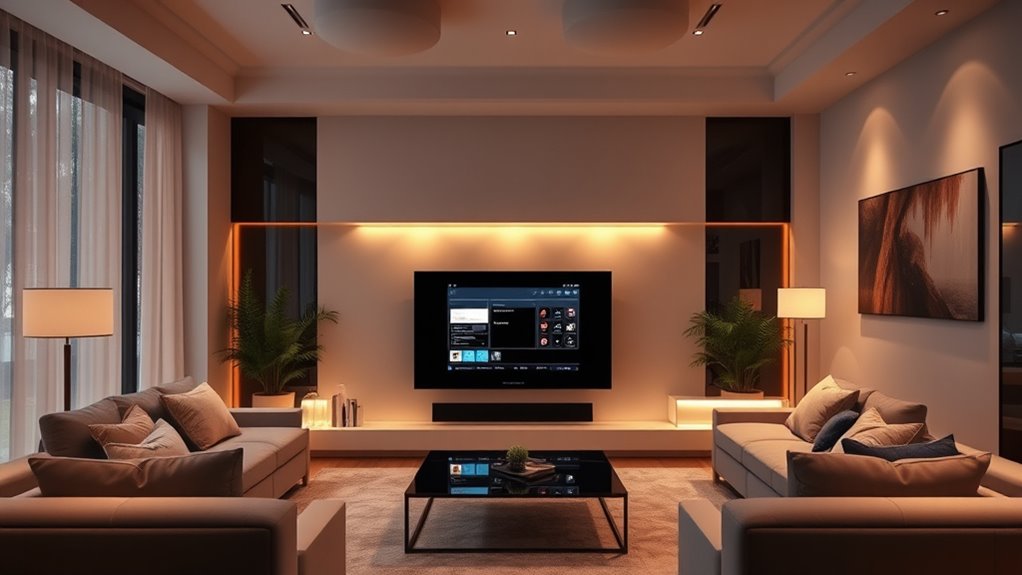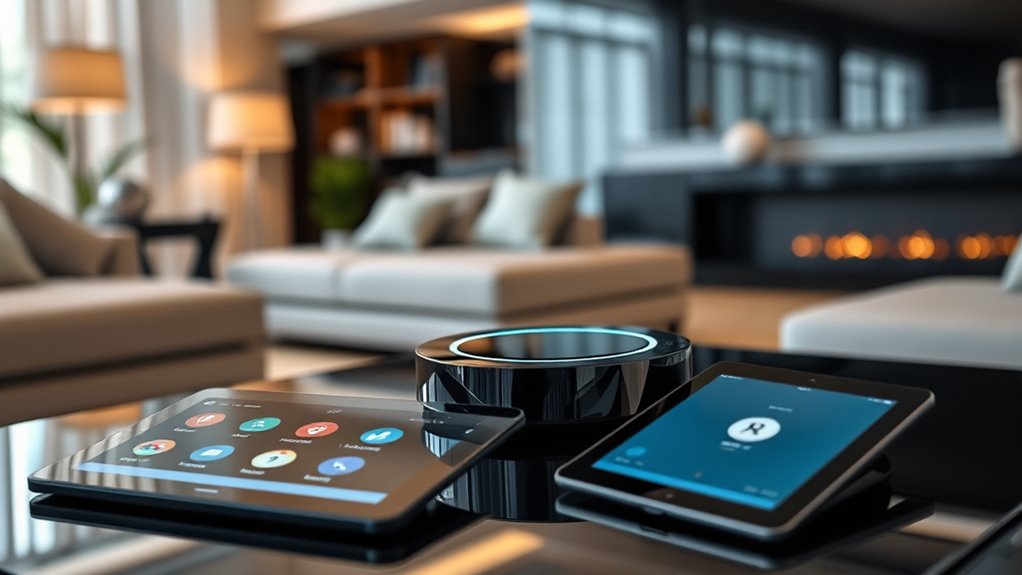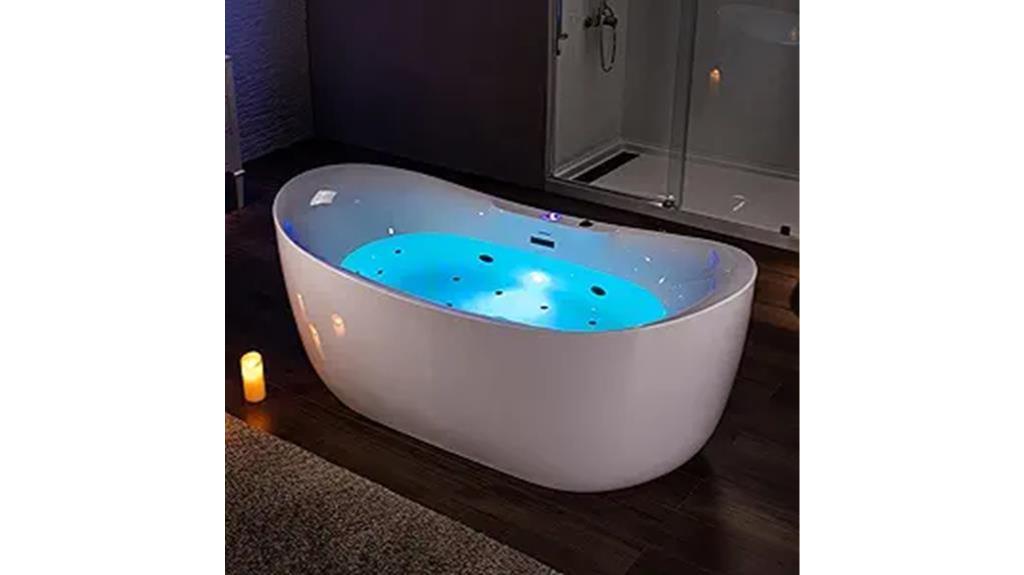If you’re looking for the 15 best premium home automation hubs that blend luxury and smart tech, I recommend considering options like the Homey Pro, Hubitat Elevation, and SmartThings Hub for their reliable connectivity, extensive device support, and advanced automation. The Philips Hue Bridge adds elegant lighting control, while remote controls like the SofaBaton X1S and smart locks enhance security and convenience. Keep exploring to discover how these hubs can truly elevate your smart home experience.
Key Takeaways
- High-end hubs like Homey Pro and Hubitat Elevation offer extensive device support, advanced automation, and local processing for premium smart homes.
- Top-tier hubs integrate multiple protocols (Zigbee, Z-Wave, Wi-Fi, Matter) ensuring seamless connectivity with luxury smart devices.
- Premium hubs prioritize privacy, security, and reliability with local control, encrypted connections, and durable hardware.
- These hubs provide sophisticated automation, scene creation, and remote management to enhance home aesthetics and convenience.
- Designed with sleek aesthetics and advanced features, premium hubs combine luxury design with cutting-edge smart technology.
Homey Pro Smart Home Hub for Home Automation
If you want a versatile, future-proof smart home hub, the Homey Pro is an excellent choice. It supports over 50,000 devices from more than 1,000 brands, including popular names like Sonos, Philips Hue, and Yale. Its seven integrated protocols—Wi-Fi, Zigbee, Z-Wave Plus, Infrared, BLE, Matter, and Thread—offer unmatched compatibility and control. You can manage everything remotely via the app or web, creating custom routines with Homey Flow. Plus, it processes data locally for privacy and quick response. With real-time energy monitoring and sensor alerts, the Homey Pro makes home automation seamless, secure, and adaptable for the future.
Best For: homeowners and tech enthusiasts seeking a highly versatile, future-proof smart home hub that supports a vast array of devices and protocols for seamless automation and control.
Pros:
- Supports over 50,000 devices from more than 1,000 brands, ensuring broad compatibility
- Features seven integrated protocols—Wi-Fi, Zigbee, Z-Wave Plus, Infrared, BLE, Matter, and Thread—for comprehensive device control
- Processes data locally for enhanced privacy, security, and reduced latency
Cons:
- Initial setup and configuration can be complex for beginners
- May require additional apps or integrations for niche or less common devices
- Higher price point compared to basic smart hubs or controllers
Hubitat Elevation Home Automation Hub (Model C-8 Pro)
The Hubitat Elevation C-8 Pro stands out as an ideal choice for advanced smart home enthusiasts who prioritize local control and broad device compatibility. It supports over 1,000 devices from more than 100 brands, including sensors, locks, thermostats, and switches, using Zigbee, Z-Wave, Wi-Fi, IR, and Matter protocols. Its local processing guarantees fast, reliable operation without relying on the cloud, even during internet outages. Designed for customization, it offers complex automation, scene creation, and virtual devices. While setup can be technical, the hub’s flexibility and privacy benefits make it perfect for power users seeking a high-performance, independent smart home ecosystem.
Best For: advanced smart home enthusiasts and power users who value local control, extensive device compatibility, and customizable automation.
Pros:
- Supports over 1,000 devices from more than 100 brands with broad protocol compatibility (Zigbee, Z-Wave, Wi-Fi, IR, Matter)
- Ensures fast, reliable operation with local processing, even during internet outages
- Highly customizable automation, scenes, and virtual devices for tailored smart home control
Cons:
- Setup can be complex and may require technical knowledge, especially for initial configuration
- User interface and mobile app can be less intuitive and somewhat regressive in design
- Initial Zigbee network setup may require troubleshooting, particularly with older devices
SmartThings Hub 3rd Generation Smart Home Automation Hub
For homeowners seeking a versatile and reliable central control for their smart devices, the SmartThings Hub 3rd Generation stands out. It supports Zigbee, Z-Wave, Wi-Fi, and cloud protocols, connecting with sensors, lighting, and appliances effortlessly. The hub integrates with Alexa and Google Assistant, enabling voice control through a single app. Setup is straightforward—scan QR codes and connect via Wi-Fi or Ethernet—often in under 15 minutes. Reliable and user-friendly, it manages automations like sensor-triggered alerts or lighting scenes. Its compact size, IP54 rating, and battery power make it suitable for various rooms. Overall, it’s a solid choice for those wanting seamless, smart home integration.
Best For: homeowners seeking a versatile, reliable smart home hub that easily integrates multiple protocols and voice assistants for seamless automation.
Pros:
- Supports multiple protocols including Zigbee, Z-Wave, Wi-Fi, and cloud-to-cloud connections for broad device compatibility
- Easy setup with quick pairing and user-friendly app interface, often under 15 minutes
- Compact, IP54-rated design with battery power suitable for various rooms and minimal space requirements
Cons:
- Occasional device disconnects or offline issues may require troubleshooting or resets
- Setup can be challenging for less tech-savvy users, especially with regional power standards and firmware updates
- Limited included accessories like power adapters, necessitating additional converters for certain regions
Homey Bridge Smart Home Hub
Homey Bridge Smart Home Hub stands out for users who want broad device compatibility and voice control options. It supports Z-Wave Plus, Zigbee, Wi-Fi, BLE, and Infrared, working with thousands of brands like Philips Hue, Sonos, Nest, and Yale. Setup is quick through the Homey app, but some users report device recognition and connectivity issues, especially with Z-Wave devices. Voice commands work with Alexa, Google, and Siri Shortcuts (separately sold). The hub offers automation flows for lights, locks, and entertainment, but the app can be clunky, and the signal range is limited without additional hardware. It’s a budget-friendly option with mixed reviews.
Best For: homeowners seeking a budget-friendly smart home hub with broad device compatibility and voice control options.
Pros:
- Supports multiple protocols including Z-Wave Plus, Zigbee, Wi-Fi, BLE, and Infrared for extensive device integration
- Easy setup via the Homey app with quick initial configuration
- Compatible with major voice assistants like Alexa, Google Home, and Siri Shortcuts (with separate devices)
Cons:
- Reports of device recognition and connectivity issues, particularly with Z-Wave devices
- Limited signal range requiring additional hardware like the Homey Pro for extended networks
- Clunky app interface and complicated automation flow creation hinder user experience
Philips Hue Bridge, Smart Lighting Hub
Are you looking to elevate your smart home experience with seamless lighting control? The Philips Hue Bridge is the perfect hub to unlock your system’s full potential, supporting up to 50 lights and accessories. It’s compatible with both indoor and outdoor Hue lights, and with Matter support, it integrates smoothly with other smart devices. Using Zigbee technology, it provides a secure, reliable connection that keeps your lights working even if your Wi-Fi drops. Plus, you can control everything remotely via the Hue app, create custom automations, and sync lights with movies, music, or games. It’s a future-proof choice for comprehensive, luxury lighting control.
Best For: smart home enthusiasts seeking a reliable, versatile, and future-proof lighting control hub to seamlessly manage indoor and outdoor lights with automation, entertainment sync, and broad device compatibility.
Pros:
- Supports up to 50 lights and accessories, ideal for comprehensive home lighting.
- Utilizes Zigbee technology for secure, stable connections without burdening Wi-Fi.
- Compatible with Matter, voice assistants, and media sync for enhanced automation and entertainment experiences.
Cons:
- Requires an initial investment in the Hue Bridge and compatible lights.
- Setup may be complex for users unfamiliar with smart home technology.
- Limited to Hue ecosystem for optimal performance, which may restrict choice of lights and accessories.
MOES ZigBee 3.0 Hub/Wired Gateway for Smart Home
The MOES ZigBee 3.0 Hub/Wired Gateway is an excellent choice for those who want a reliable, stable connection to manage multiple ZigBee devices across large or multi-floor homes. Its compact design and Ethernet or WiFi connectivity make installation straightforward, while the impressive range of over 200 meters guarantees strong signals throughout your property. It seamlessly integrates with Tuya-compatible devices like switches, lights, and sensors, supporting remote access and automation. Though it’s tailored mainly for MOES-specific ZigBee products and speaks Chinese during setup, it offers dependable performance and a simple way to expand your smart home within the TUYA ecosystem.
Best For: homeowners seeking a reliable, stable ZigBee hub to manage multiple devices across large or multi-floor homes within the TUYA ecosystem.
Pros:
- Easy to set up with straightforward installation options via Ethernet or WiFi.
- Offers impressive range of over 200 meters, suitable for large properties.
- Compatible with Tuya ZigBee devices like switches, lights, and sensors, supporting remote access and automation.
Cons:
- Primarily works with MOES-specific ZigBee devices and may not support standard ZigBee equipment.
- The setup interface speaks Chinese during device addition, with no current English language option.
- Bright LED indicators are not configurable and can be distracting in dark environments.
Sengled Z02-hub Smart Hub for Alexa and Google Assistant
If you want a smart hub that seamlessly integrates with both Alexa and Google Assistant, the Sengled Z02-hub is an excellent choice. It connects easily via Ethernet and guides you through setup with its in-app instructions. Once connected, it can manage up to 64 Sengled smart lights and accessories, making it perfect for expanding your system. You can control everything through the Sengled Home app, where you set schedules, group devices, and oversee your entire ecosystem. This hub acts as the central control point, enabling hands-free voice commands and smooth automation across rooms, blending luxury with smart technology effortlessly.
Best For: homeowners seeking a reliable smart hub that seamlessly integrates with both Alexa and Google Assistant for comprehensive voice-controlled smart home management.
Pros:
- Compatible with Alexa and Google Assistant for versatile voice control
- Supports up to 64 Sengled smart lights and accessories for extensive automation
- Easy setup via Ethernet connection and in-app guide for quick installation
Cons:
- Sold as a single pack, which may require multiple hubs for larger systems
- Limited to Sengled smart products; incompatible with other brands
- Requires a stable internet connection and app management for optimal performance
Kasa Smart Plug HS103P4, 4-Pack Wi-Fi Outlet with Alexa & Google Compatibility
For anyone seeking a reliable and easy-to-use smart outlet, the Kasa Smart Plug HS103P4 offers a perfect solution. This 4-pack Wi-Fi outlet is compatible with Alexa, Google Assistant, and IFTTT, requiring no hub for setup. It supports up to 15 amps and features a sleek white design, blending seamlessly into any home. With the Kasa app, I can control my devices remotely, set schedules, timers, and countdowns, making automation simple. Compatible with Android 5.0+ and iOS 10.0+ devices, it provides convenient voice control and peace of mind, backed by UL safety certification and the trust of over 5 million users.
Best For: homeowners and renters seeking an easy, reliable way to automate and control multiple devices remotely using voice commands or scheduled timers.
Pros:
- Easy setup with no hub required, compatible with Alexa, Google Assistant, and IFTTT
- Supports up to 15 amps, suitable for most household appliances
- Compact, sleek white design that blends seamlessly into any home environment
Cons:
- Requires a stable 2.4GHz Wi-Fi connection for optimal performance
- Limited to 15 amps, may not support high-power appliances like large HVAC units
- App control and scheduling features depend on smartphone compatibility and internet access
Emporia Vue 3 Home Energy Monitor for Smart Home Automation
Emporia Vue 3 stands out as an ideal choice for homeowners seeking detailed energy monitoring and cost-saving automation. I appreciate its UL and CE certifications, ensuring safety and reliability. It tracks real-time electricity use across up to 16 circuits with ±2% accuracy, helping me identify high-consumption appliances. The system integrates seamlessly with WiFi, providing live data via mobile apps and cloud storage. With features like solar and net metering monitoring, I can optimize energy use and reduce bills. Installation is straightforward for qualified electricians, and the detailed insights empower me to make smarter energy decisions. Overall, Vue 3 combines precision, convenience, and smart control for a truly efficient home.
Best For: homeowners and energy-conscious individuals seeking detailed, real-time energy monitoring and automation to reduce utility costs and optimize home energy use.
Pros:
- Certified safe and reliable with UL and CE listings.
- Accurate energy tracking across multiple circuits with ±2% precision.
- Seamless integration with WiFi and smart home apps for remote monitoring and control.
Cons:
- Installation requires working near high-voltage wires; professional help recommended.
- Limited panel space may pose challenges for larger setups.
- Some users experience minor data discrepancies or space constraints in panels.
The Arre Smart Button stands out as an ideal accessory for those seeking seamless integration within their advanced smart home ecosystems. Supporting Matter and Thread standards, it works effortlessly with Apple HomeKit and Samsung SmartThings. Thread enables faster, low-latency connections, especially when paired with a Thread Border Route like the HomePod Mini. With three trigger options—single, double, and long press—you can customize actions such as controlling lights or locks. Its tactile, satisfying click, LED indicator, and magnetic mounting make setup and placement easy. Although some connectivity issues exist, overall, it’s a reliable, versatile device that enhances smart home convenience with a sleek, premium design.
Best For: tech-savvy smart home enthusiasts seeking seamless, customizable, and reliable integration with Apple HomeKit and other Matter-compatible ecosystems.
Pros:
- Supports Matter and Thread standards for broad compatibility and faster connections.
- Easy setup via Apple Home app with customizable trigger actions.
- Sleek, premium design with magnetic mounting and personalization options.
Cons:
- Occasional connectivity dropouts and brief unresponsiveness reported by some users.
- Limited direct shortcut execution due to current HomeKit and Shortcuts app restrictions.
- Battery replacement can be tricky to access and battery life details are not extensively reported.
SONOFF Zigbee 3.0 USB Dongle Plus Gateway
Looking to upgrade your home automation setup with a reliable Zigbee gateway? The SONOFF Zigbee 3.0 USB Dongle Plus Gateway is an excellent choice. It’s a universal Zigbee USB adapter pre-flashed with Z-Stack 3.x.0 firmware, supporting Zigbee2MQTT and ZHA, making integration seamless with systems like Home Assistant. Based on the TI CC2652P chip and equipped with an external SMA antenna, it offers strong signal strength and stability. Its plug-and-play setup is straightforward, especially with a USB extension cable to prevent interference. Compatible with a wide range of devices, it’s a cost-effective, high-performance solution for creating a robust Zigbee mesh network in your smart home.
Best For: home automation enthusiasts seeking a reliable, high-performance Zigbee gateway compatible with popular systems like Home Assistant and Zigbee2MQTT.
Pros:
- Easy plug-and-play setup with minimal configuration required
- Strong signal strength with external SMA antenna and interference reduction via aluminum housing
- Broad device compatibility and firmware upgradability for future-proofing
Cons:
- Requires a USB extension cable to avoid interference and ensure optimal signal stability
- No official support from Sonoff; relies on third-party firmware and community troubleshooting
- Advanced features like firmware flashing may require technical knowledge and additional tools
Aqara Smart Lock U100 with Fingerprint and Keyless Entry
If you want a smart lock that seamlessly integrates with your Apple ecosystem and offers multiple unlocking methods, the Aqara Smart Lock U100 is an excellent choice. It supports Apple HomeKit, Apple Home Key, and third-party platforms like Alexa and Google, enabling automated routines and remote access via the Aqara app or Zigbee hub. Opening options include fingerprint recognition (up to 50 fingerprints), NFC, keypad code, mechanical key, and Apple devices like iPhone or Apple Watch. Its sleek, weatherproof design, long-lasting batteries, and strong security features make it a reliable, convenient, and luxurious addition to any smart home.
Best For: Homeowners and smart home enthusiasts seeking a secure, seamless, and Apple-compatible smart lock with multiple unlocking options and durable design.
Pros:
- Supports Apple HomeKit, Apple Home Key, and third-party platforms for versatile automation and remote access
- Multiple unlocking methods including fingerprint, NFC, keypad code, mechanical key, and Apple devices for convenience
- Weatherproof construction with long battery life and high security standards for reliable outdoor use
Cons:
- Setup can sometimes experience delays, requiring initial configuration in the Aqara app before HomeKit integration
- Keypad input less user-friendly due to non-physical buttons and the need to wake the screen before entering codes
- Requires Aqara hub for full remote management and advanced features, adding an extra component to the setup
SofaBaton X1S Universal Remote with Hub and App
For anyone seeking seamless control over multiple devices, the SofaBaton X1S Universal Remote with Hub and App stands out with its extensive compatibility and advanced features. It supports over 6,000 brands and 500,000 device models, ensuring it works with current and future electronics. The included SofaBaton Hub provides 360-degree control with two IR blasters, eliminating blind spots and allowing control from anywhere in the room. Customizable one-touch activities, voice commands via Alexa or Google Assistant, and a user-friendly LCD screen make managing your entertainment effortless. Plus, features like a Find My Remote function and API integration enhance convenience and expand automation possibilities.
Best For: tech enthusiasts and home entertainment enthusiasts seeking a highly compatible, customizable, and voice-controlled universal remote solution.
Pros:
- Supports over 6,000 brands and 500,000 device models for extensive compatibility
- Equipped with a hub that provides 360-degree control and eliminates blind spots
- Features customizable activities, voice control, and API integration for personalized automation
Cons:
- Setup may be complex for users unfamiliar with smart home devices
- The remote and hub may be costly compared to simpler universal remotes
- Reliance on app and API features may require additional configuration and updates
Lockin Wi-Fi Gateway and Electronic Lock Component for Smart Lock Control
The Lockin Wi-Fi Gateway stands out as an ideal choice for homeowners and property managers seeking reliable, remote control over their smart locks and lockboxes. Compatible with Q3/Q1 Smart Door Knob and L1 Smart Box, it supports multiple devices for seamless management. Setup takes just two minutes—plug in, connect via app, and you’re ready to go. It offers real-time lock status, activity logs, and remote code management, all over a secure Wi-Fi connection. Supporting voice control with Alexa, it’s perfect for home security, rentals, or property management. Note that it’s not compatible with the Veno series, but overall, it provides a reliable, smart security solution.
Best For: homeowners, property managers, and Airbnb hosts seeking a reliable, easy-to-setup Wi-Fi gateway for remote control and management of smart locks and lockboxes.
Pros:
- Quick and simple setup within 2 minutes with app connectivity
- Supports multiple devices and remote management of lock codes and status
- Compatible with voice control via Amazon Alexa for added convenience
Cons:
- Not compatible with Lockin Veno series lockboxes or Veno locks
- Does not plug directly into outlets, which may affect placement options
- Limited remote code creation capabilities reported by some users
HomeKit Smart Fingerprint Lock with Keypad
Designed specifically for interior doors like bedrooms, offices, and storage rooms, the HomeKit Smart Fingerprint Lock with Keypad offers a seamless blend of security and convenience. It’s compatible with iOS devices and requires a HomeKit hub for remote access, automations, and Siri commands. The lock supports multiple unlocking methods—fingerprint, passcode, key, app, and Siri—providing flexible access options. Its advanced fingerprint recognition learns over time for faster, more accurate identification. With a durable, water-resistant zinc alloy build, easy DIY installation, and battery life lasting up to a year, it’s a smart, stylish upgrade for any interior door.
Best For: homeowners, office managers, or rental property owners seeking a secure, keyless, and stylish interior door lock with smart features and easy DIY installation.
Pros:
- Supports multiple unlocking methods including fingerprint, passcode, key, app, and Siri for versatile access.
- Advanced fingerprint recognition learns over time for faster, more accurate identification.
- Durable, water-resistant zinc alloy construction with up to one year of battery life and simple DIY installation.
Cons:
- Requires a HomeKit hub and compatible iOS device for remote access and automations.
- Batteries are not included and need replacement approximately annually.
- Designed primarily for interior doors; may not suit external or heavily trafficked exterior doors.
Factors to Consider When Choosing Premium Home Automation Hubs

When selecting a premium home automation hub, I consider factors like protocol compatibility and ecosystem integration to make sure everything works smoothly together. I also look for strong local control capabilities and automation flexibility so I can customize my setup easily. Finally, I check the device support range to make sure my hub can handle all the gadgets I want to connect.
Protocol Compatibility
Ever wondered if your home automation hub can connect all your devices seamlessly? Protocol compatibility is essential. A top-tier hub should support multiple standards like Zigbee, Z-Wave, Wi-Fi, Bluetooth, and Thread, ensuring it can communicate with a variety of devices across different ecosystems. This broad support means you won’t need multiple controllers cluttering your space. Many premium hubs now also support emerging standards like Matter, which promotes interoperability among different brands and ecosystems. Compatibility with voice assistants such as Alexa, Google Home, and Siri often hinges on the protocols supported. Additionally, choosing a hub that offers local processing for key protocols enhances privacy, reduces latency, and minimizes reliance on cloud services. In short, protocol compatibility directly impacts your smart home’s flexibility and ease of use.
Ecosystem Integration
Choosing a premium home automation hub means ensuring it seamlessly integrates with your existing ecosystem, so you can control all your devices effortlessly. A great hub supports multiple ecosystem integrations like Apple HomeKit, Google Home, and Amazon Alexa, giving you broad compatibility. Compatibility with standards like Zigbee, Z-Wave, and Matter is vital for connecting devices from various brands without hassle. Open platform support or community-developed apps enable customization and future upgrades, making your system adaptable. Cross-platform voice assistant support allows you to control devices via Siri, Alexa, or Google Assistant, adding flexibility. A well-integrated hub minimizes the need for multiple bridges, offering unified control and simplifying your smart home experience. This integration is key to achieving a seamless, luxurious ecosystem that works effortlessly.
Local Control Capabilities
Prioritizing local control capabilities in a home automation hub guarantees your smart devices can operate reliably without dependence on cloud services. This means your system stays functional even during internet outages, ensuring peace of mind. Devices supporting local control typically communicate through protocols like Z-Wave, Zigbee, or Thread, enabling direct device-to-device interactions. This setup reduces latency, making automation responses faster and more seamless. Additionally, local processing enhances security by limiting data transmission over the internet, safeguarding your privacy. With strong local control, you can customize automation rules and manage devices directly, which improves responsiveness and privacy. Choosing a hub with robust local capabilities ensures your smart home remains reliable, secure, and efficient, regardless of internet stability.
Automation Flexibility
When selecting a premium home automation hub, it’s crucial to take into account its automation flexibility, which determines how well it can adapt to your evolving needs. A flexible hub supports complex automation flows, enabling multi-step routines triggered by specific conditions or device states. Compatibility with multiple protocols like Zigbee, Z-Wave, Thread, and Matter broadens control over diverse devices across different ecosystems. Open platforms and customizable tools, such as visual flow builders or scripting options, let you tailor automation scenarios precisely. Integration with voice assistants and third-party services further enhances flexibility by allowing voice commands and external triggers. Additionally, the ability to add new devices via official or community-developed apps ensures your automation system can grow with your home, maintaining its relevance and functionality over time.
Device Support Range
A broad device support range is essential because it guarantees your smart home hub can communicate with a variety of products from different brands and protocols. With support for over 50,000 devices from more than 1,000 brands, premium hubs ensure compatibility across Zigbee, Z-Wave, Wi-Fi, and Matter protocols. This multi-protocol capability allows a single hub to connect with sensors, locks, lights, and entertainment systems, streamlining your setup. Compatibility with voice assistants like Alexa, Google Home, and Siri expands control options, making managing your devices more seamless. Plus, an extensive support range future-proofs your investment, as new devices and standards can be integrated effortlessly through official and community-developed apps. This versatility reduces the need for multiple hubs and simplifies your smart home ecosystem.
Privacy and Security
Choosing a premium home automation hub means guaranteeing your privacy and security are built into its core. I look for hubs that prioritize local processing, which minimizes reliance on cloud services and reduces vulnerabilities. Robust encryption, like AES-256, is essential to protect my data and device communications. Regular firmware updates and security patches are critical, as they fix vulnerabilities and keep my system secure. I also value support for secure authentication methods, such as two-factor authentication or biometric access, to safeguard my accounts and devices. Compatibility with industry standards like Thread, Zigbee, Z-Wave, and Matter ensures my devices communicate securely across different ecosystems. Overall, a focus on these security features gives me confidence that my smart home remains private and protected.
Ease of Setup
Setting up a premium home automation hub should be quick and straightforward, so I look for systems that offer guided app instructions or quick pairing methods. A good hub simplifies the process with detailed documentation, tutorials, or community support to help troubleshoot during setup. Compatibility with various protocols like Wi-Fi, Zigbee, or Z-Wave makes initial integration smoother, reducing frustration. An intuitive mobile app or web interface that guides me step-by-step through adding devices and creating automations is essential. Features like automatic device detection, minimal wiring, and plug-and-play hardware contribute to a hassle-free installation. Overall, a system with these qualities guarantees I spend less time configuring and more time enjoying my smart home’s luxury features.
Frequently Asked Questions
How Secure Are Premium Home Automation Hubs Against Hacking?
Premium home automation hubs are quite secure, but no system is entirely hack-proof. I make sure to choose hubs with robust encryption, regular firmware updates, and strong password requirements. I also enable two-factor authentication whenever possible. Staying vigilant and practicing good cybersecurity habits help me protect my smart home from potential threats. Overall, investing in reputable brands and keeping my system updated gives me peace of mind.
Can These Hubs Integrate With Existing Smart Home Devices?
Yes, premium home automation hubs can often integrate seamlessly with your existing smart home devices. I’ve found that most high-end hubs support a wide range of protocols like Z-Wave, Zigbee, and Wi-Fi, making it easy to connect devices from different brands. This compatibility allows me to centralize control and enhance my smart home experience without needing to replace what I already have.
What Is the Average Setup Time for a Premium Hub?
Most premium hubs take about 30 to 60 minutes to set up, depending on your existing devices and network complexity. I’ve found that with a clear plan and good Wi-Fi, it usually takes me around 45 minutes to get everything running smoothly. Notably, 70% of users report that the initial setup is faster than expected, especially when following detailed instructions or using automated app guides.
Do Premium Hubs Support Voice Control Across Multiple Platforms?
Yes, premium hubs support voice control across multiple platforms, making your smart home experience seamless. I’ve found that most high-end hubs integrate with popular voice assistants like Alexa, Google Assistant, and Siri, allowing me to control lights, thermostats, and security effortlessly. This multi-platform support means I don’t have to stick to one ecosystem, giving me flexibility and convenience to manage my smart devices with just my voice, no matter which platform I prefer.
How Scalable Are These Hubs for Expanding Smart Home Systems?
Think of these hubs as the backbone of your smart home universe—they’re surprisingly scalable. I’ve found that premium hubs are like a well-designed city grid, allowing you to easily add new devices without chaos. They support expanding your system smoothly, whether you’re adding lights, security, or entertainment. With their flexible architecture, you can grow your smart home as effortlessly as planting seeds that flourish into a thriving garden.
Conclusion
So, there you have it—my quick rundown of the top premium home automation hubs. Whether you’re after luxury, tech prowess, or just bragging rights, there’s something here for you. Remember, choosing the right hub isn’t just about features; it’s about making your home smarter (or at least pretending to be). Now go ahead, pick one, and watch your house become the envy of all your neighbors—because who doesn’t want a castle?





![SmartThings Hub 3rd Generation [GP-U999SJVLGDA] Smart Home Automation Hub Home](https://m.media-amazon.com/images/I/21hChu0ounL._SL500_.jpg)



















